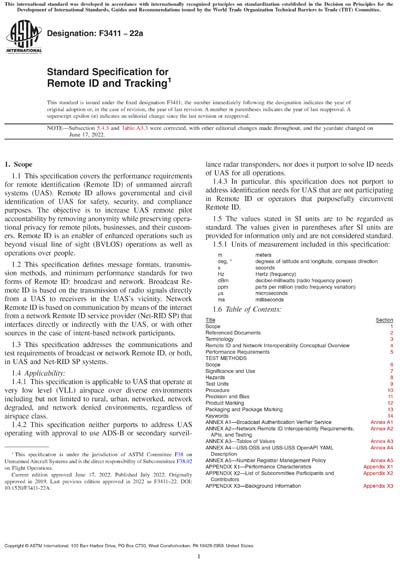Most recent
ASTM F3411-22a
Standard Specification for Remote ID and Tracking
1.1This specification covers the performance requirements for remote identification (Remote ID) of unmanned aircraft systems (UAS). Remote ID allows governmental and civil identification of UAS for safety, security, and compliance purposes. The objective is to increase UAS remote pilot accountability by removing anonymity while preserving operational privacy for remote pilots, businesses, and their customers. Remote ID is an enabler of enhanced operations such as beyond visual line of sight (BVLOS) operations as well as operations over people.
1.2This specification defines message formats, transmission methods, and minimum performance standards for two forms of Remote ID: broadcast and network. Broadcast Remote ID is based on the transmission of radio signals directly from a UAS to receivers in the UAS's vicinity. Network Remote ID is based on communication by means of the internet from a network Remote ID service provider (Net-RID SP) that interfaces directly or indirectly with the UAS, or with other sources in the case of intent-based network participants.
1.3This specification addresses the communications and test requirements of broadcast or network Remote ID, or both, in UAS and Net-RID SP systems.
1.4Applicability:
1.4.1This specification is applicable to UAS that operate at very low level (VLL) airspace over diverse environments including but not limited to rural, urban, networked, network degraded, and network denied environments, regardless of airspace class.
1.4.2This specification neither purports to address UAS operating with approval to use ADS-B or secondary surveillance radar transponders, nor does it purport to solve ID needs of UAS for all operations.
1.4.3In particular, this specification does not purport to address identification needs for UAS that are not participating in Remote ID or operators that purposefully circumvent Remote ID.
1.5The values stated in SI units are to be regarded as standard. The values given in parentheses after SI units are provided for information only and are not considered standard.
1.5.1Units of measurement included in this specification:
1.6Table of Contents:
1.7This standard does not purport to address all of the safety concerns, if any, associated with its use. It is the responsibility of the user of this standard to establish appropriate safety, health, and environmental practices and determine the applicability of regulatory limitations prior to use. Some specific hazards statements are given in Section 8 on Hazards.
1.8This international standard was developed in accordance with internationally recognized principles on standardization established in the Decision on Principles for the Development of International Standards, Guides and Recommendations issued by the World Trade Organization Technical Barriers to Trade (TBT) Committee.
ASTM International [astm]

